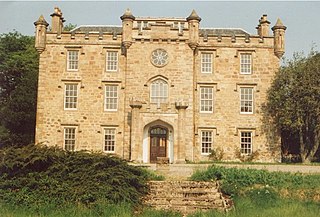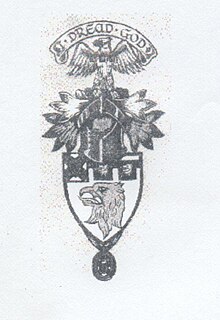
Novar House is an 18th-century building, located 0.7 miles north of the village of Evanton in Ross, Scotland. It is built on the site of an earlier castle. [1]

Novar House is an 18th-century building, located 0.7 miles north of the village of Evanton in Ross, Scotland. It is built on the site of an earlier castle. [1]

The Munros of Novar descend from John Munro, 1st of Milntown, who in turn was the second son of Hugh Munro, 9th Baron of Foulis (d.1425).
The lands of the Novar Estate were acquired in 1589 from William Keith of Delny by Neil Munro of Swordale, whose brother Andrew Munro was the ancestor of the Novar branch of the Clan Munro. At the time the Novar lands covered one quarter of the lands known as Fyrish.
There is a datestone of 1634 built into the side of the original Novar House, which is now part of the west side of the inner courtyard. Robert Munro, 2nd of Novar was named as one of the early Scottish justices of the peace in 1634. The house was enlarged considerably in 1720 with a three-storey building facing south under Hector Munro, 4th of Novar.

The current house and estate of Novar are largely the creation of Sir Hector Munro, 8th of Novar (1726–1805) who made his name and fortune as an officer in the British Army who fought in India. Early maps call it 'Tenuer' (Gaelic Tigh 'n fhuamhair, house of the giant).
The building was altered and rebuilt as a classical square by Sir Hector Munro on his return from India in 1765. (The Edinburgh Evening Courant of 22 June 1771 reported that a slave called Caesar, from the East Indies, had escaped from Novar.) Sir Hector Munro of Novar provided a ballroom with minstrels' gallery, and the main lines of the present mansion appear on estate plans of 1777 and 1778. Sir Hector Munro also carried out extensive agricultural improvements and afforestation, including the planting of approximately 778,000 firs and Scots pine during the period of 1788 to 1792. [2] The woodlands were renewed on a regular system by successive owners. The eastern lands of Fyrish were added to the Novar estate when they were passed from the Munro of Culrain family to the Munro of Novar family during the 18th century, thus the Novar lands becoming even larger.
Sir Hector Munro's sons were both killed in India, one by a tiger and one by a shark in the Bay of Bengal. Therefore, the estate passed, after the death of his nephew Hugh Andrew Johnstone Munro of Novar, to his daughter Jean Munro who married Ronald Ferguson of Raith. [3]
Present day, Novar is a thriving estate still owned and run by the Munro Ferguson family. Novar Estate extends to 20,000 acres (80 km2) between the Allt Graad and the River Alness and incorporates farming, forestry, open hill, traditional country sports, fishing, over 150 miles of paths and tracks, a hydroelectric scheme and the first wind farm in the Highlands. [4]
Assynt House is a Georgian country house, built as a dower house for Novar House.
President Franklin D Roosevelt and Eleanor spent part of their honeymoon there. 7
Assynt House was later the home of the artist Lady Isobel Blunt-Mackenzie (b. 1922 – d. 1962), sister of the 4th Earl of Cromartie, and her husband Captain Oscar Linda, son of General Maximilian Linda of Zakopane, Poland. [5]
By 2002 it had fallen into disrepair. It has since been refurbished and operates as a luxury holiday house for private rental. [6]

General Sir Hector Munro, 8th laird of Novar KB was a British soldier who became the ninth Commander-in-Chief of Bengal (1764–1765).

Clan Mackenzie is a Scottish clan, traditionally associated with Kintail and lands in Ross-shire in the Scottish Highlands. Traditional genealogies trace the ancestors of the Mackenzie chiefs to the 12th century. However, the earliest Mackenzie chief recorded by contemporary evidence is Alexander Mackenzie of Kintail who died some time after 1471. Traditionally, during the Wars of Scottish Independence, the Mackenzies supported Robert the Bruce, but feuded with the Earls of Ross in the latter part of the 14th century. During the 15th and 16th-centuries the Mackenzies feuded with the neighboring clans of Munro and MacDonald. In the 17th century the Mackenzie chief was made Earl of Seaforth in the peerage of Scotland. During the Scottish Civil War of the 17th century the Mackenzies largely supported the Royalists. During the Jacobite rising of 1715 the chief and clan of Mackenzie supported the Jacobite cause. However, during the Jacobite rising of 1745 the clan was divided with the chief, Kenneth Mackenzie, Lord Fortrose, supporting the British-Hanoverian Government and his relative, George Mackenzie, 3rd Earl of Cromartie, supporting the Jacobites.
Colonel Sir Hector Munro was a Scottish chief and military officer. He was the 32nd Chief of the Scottish Highland Clan Munro, 29th Baron and 11th Baronet of Foulis.
Colonel Robert Munro of Foulis, also known as the Black Baron, was traditionally the 18th Baron of Foulis in Scotland. He was a soldier of fortune, who served in Germany under the banners of Gustavus Adolphus, king of Sweden. It is not certain how he got his epithet of the 'Black Baron', but quite possibly it was from the colour of his hair rather than any perceived martial ferocity. Although this Robert Munro is traditionally 18th Baron and 21st overall chief of the Clan Munro, he is only the 11th Munro chief that can be proved by contemporary evidence.

The Monro of Fyrish family were a Scottish family and branch of the ancient highland Clan Munro. The family produced a notable dynasty of doctors to London in the 18th and 19th century where they were involved in early work on curing 'insanity'. Four generations occupied successively the position of (Principal) Physician of the notorious Bethlem Hospital (Bedlam). They were also leading members of a variety of important medical associations. Other members were painters, priests and philanthropists of note and one was an important early patron to J. M. W. Turner.

Fyrish is the name given to an ancient area of land found just north of Evanton, Ross-shire, Scotland.

Teaninich Castle is situated north of the village of Evanton and just south of the town of Alness in Ross and Cromarty, Scotland.
The Munros of Milntown were a family cadet branch of the Highland Clan Munro. As the earliest recorded cadet branch of the Munro chiefs, the Munros of Milntown were the 'senior' cadet branch of the clan, and spawned many cadet branches. They were frequently recorded as 'Monro' as well as Munro. The Munros of Milntown are notable for being involved in events concerning the history of the late Middle Ages in the Scottish Highlands.
Robert Mor Munro, 15th Baron of Foulis, and 18th chief of the Clan Munro was a 16th-century Scottish chief. He was known as Robert Mor on account of his large stature. He was the eldest son of Robert Munro, 14th Baron of Foulis. Although this Robert Munro is traditionally 15th Baron and 18th overall chief of the clan, he is only the 8th Munro chief that can be proved by contemporary evidence.
Contullich Castle was a castle located a few miles north-west of the town of Alness, on the eastern side of the county of Ross-shire, Scotland.
Robert Munro, 14th Baron of Foulis was a Scottish soldier and clan chief of the Highland Clan Munro. He was seated at Foulis Castle. Although he is traditionally the 14th Baron and 17th overall chief of the clan, he is only the 7th Munro chief that can be proved by contemporary evidence.
Sir Hector Munro, 1st Baronet of Foulis was a Scottish soldier, noble and clan chief of the highland Clan Munro. He is also by tradition the 19th Baron and 22nd overall chief of the clan. He is however the 12th chief of the Clan Munro who can be proved by contemporary evidence.
Hector Munro, 13th Baron of Foulis was a Scottish clan chief of the highland Clan Munro in Rosshire. He is by tradition 13th Baron of Foulis and 16th overall chief of the clan. However, he is only the 6th chief of the Clan Munro who can be proved by contemporary evidence.

The Munros of Obsdale were a Scottish family and a cadet branch of the Clan Munro, a Highland Scottish clan. Their base was at Obsdale House, situated just north of the town of Alness in the Scottish Highlands. Some of the members of the Munro of Obsdale family were amongst the most distinguished Scottish military officers of the 17th century.

Clan Munro is a Highland Scottish clan. Historically the clan was based in Easter Ross in the Scottish Highlands. Traditional origins of the clan give its founder as Donald Munro who came from the north of Ireland and settled in Scotland in the eleventh century, though its true founder may have lived much later. It is also a strong tradition that the Munro chiefs supported Robert the Bruce during the Wars of Scottish Independence. The first proven clan chief on record however is Robert de Munro who died in 1369; his father is mentioned but not named in a number of charters. The clan chiefs originally held land principally at Findon on the Black Isle but exchanged it in 1350 for Estirfowlys. Robert's son Hugh who died in 1425 was the first of the family to be styled "of Foulis", despite which clan genealogies describe him as 9th baron.
John Munro, 2nd of Lemlair was a Scottish soldier who fought as a colonel in the Wars of the Three Kingdoms. His seat was at Lemlair House.
The Munros of Culrain were a minor noble Scottish family and a cadet branch of the ancient Clan Munro, a Scottish clan of the Scottish Highlands. They were seated at Culrain which is in the south of the county of Sutherland, but to the north of the main Munro clan lands in Kiltearn, Easter Ross.
Angus Roy Mackay, 9th of Strathnaver, was the ninth chief of the ancient Clan Mackay, a Scottish clan of the Scottish Highlands.
The Munros of Kiltearn were a minor noble Scottish family and a branch of the ancient Clan Munro, a Scottish clan of the Scottish Highlands.They were seated at Kiltearn House which was a manor house that shared the same name of the parish it was situated in, Kiltearn. In Scottish Gaelic the Munros of Kiltearn are known as the Sliochd-Alastair-Mhic-Uistean. The most famous member of the Munro of Kiltearn family was Donald Monro, High Dean of the Isles.
The Barony of Muirton is a Scottish feudal barony near Forres along the Findhorn River in Moray.
| Wikimedia Commons has media related to Novar House . |